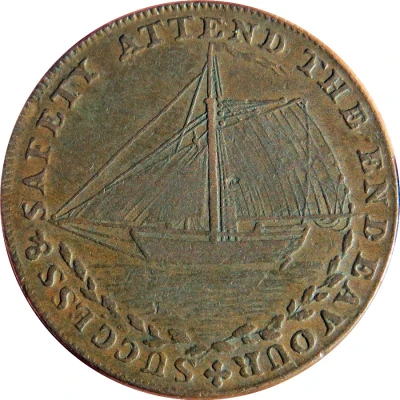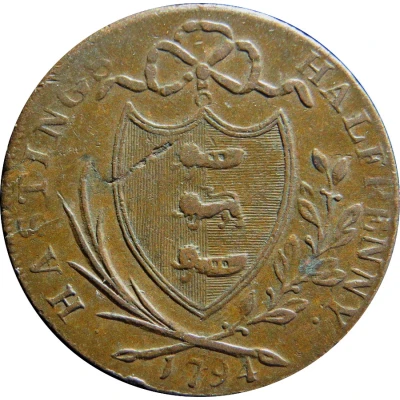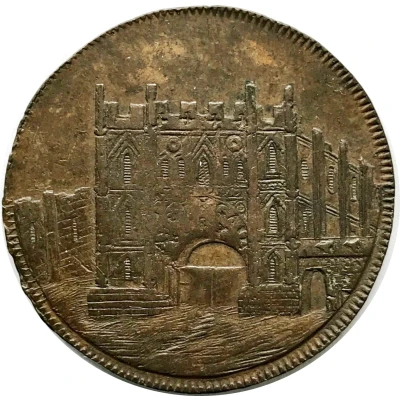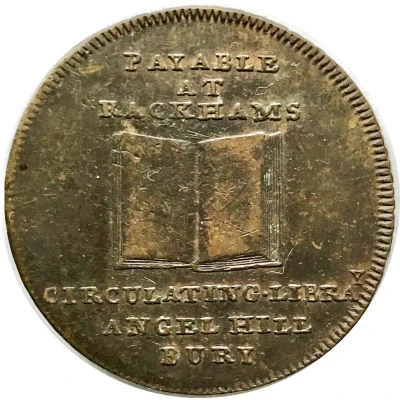
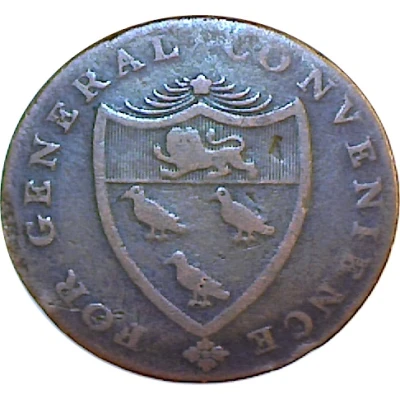

© ZacUK
½ Penny Kent - Goudhurst
1794 year| Copper | 9.42 g | 29.3 mm |
| Issuer | United Kingdom (United Kingdom, British Overseas Territories and Crown Dependencies) |
|---|---|
| Type | Token |
| Year | 1794 |
| Value | ½ Penny (1⁄480) |
| Currency | Conder tokens (1787-1797) |
| Composition | Copper |
| Weight | 9.42 g |
| Diameter | 29.3 mm |
| Thickness | 1 mm |
| Shape | Round |
| Technique | Milled |
| Orientation | Coin alignment ↑↓ |
| Demonetized | Yes |
| Updated | 2024-10-09 |
| Numista | N#79071 |
|---|---|
| Rarity index | 86% |
Reverse
Lettering around shield of arms of the city of Canterbury (a lion over three birds facing left). A radiant star above, ornament below, no border
Script: Latin
Lettering: FOR GENERAL CONVENIENCE
Engraver: F. Arnold
Edge
Plain with lettering and six ornaments
Lettering: PAYABLE BY W·MYNS GOUDHURST ++++++
Comment
The edge lettering refers to William Myns who was a freeholder and general shopkeeper with a business in Goudhurst. Struck from a late state of the obverse die with flaw left of date. Without M countermark stamped above horse; it helped distinguish it from the similar Fuggles issue (edge reads PAYABLE BY W·FUGGLE'S GOUDHURST).Manufacturer is William Lutwyche; he developed a thriving trade in the production of tokens for various merchants in Kent. Among his many commissions were those for William Fuggle, a tallow chandler, and William Mynn, a shopkeeper, both residing in Goudhurst. Lutwyche used identical dies for both issuers, altering the edge inscription to distinguish between the two. William Fuggle got his tokens first, but he seems to have resisted the mis-spelling of his name as Friggles (DH Kent 28) and the issue was suppressed until it could be corrected. The second generation of these dies (DH Kent 28c) were struck on a flan intended for William Peckham, also a Lutwyche client. It’s likely that this was in error as it may have been too much of a stretch, even for Lutwyche, to use the same dies for three issuers. In any case, Peckham had his own set of dies engraved (DH Kent 3) although it is interesting to note that on at least on a few occasions, an errant Friggles flan received the impression of the dies from his token (DH Kent 3a). Before Fuggle received his corrected order, Lutwyche had already moved on to striking tokens with the same dies for William Mynn (DH Kent 29). Lutwyche then completed the order for Fuggle with two variations (DH Kent 28a and 28b). By this time both Fuggle and Mynn had become aware of the confusion and began counter-stamping their respective tokens with an “F” or an “M”, while Fuggle took the additional step of actually cancelling the inscription on inappropriate edges.
Interesting fact
The A Token ½ Penny (Kent - Goudhurst) 1794 coin from the United Kingdom is interesting because it was issued during a time of currency shortages and was used as a substitute for the official copper coins of the Royal Mint. It was minted by a private company and was not officially sanctioned by the government, making it a unique piece of numismatic history.
